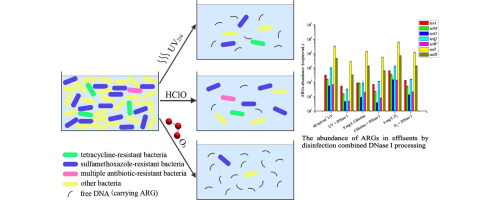Abstract
Antibiotic resistance genes (ARGs) in environment have gradually engendered extensive concern recently due to the harm caused to environment and human beings. Wastewater treatment plants are considered as important nodes of ARGs controlling and it is of utmost importance to figure out effects and mechanisms of each process, especially disinfections. In this study, three disinfection processes (ultraviolet, chlorination, and ozone) were used to reduce levels of ARGs in secondary effluents from a municipal wastewater treatment plant. Results indicated that the abundance of ARGs decreased exponentially as the dosage increased during the ultraviolet disinfection treatment (R2 = 0.68–0.92). In the 0–5 mg/L available chlorine concentrations, with a contact time of 30 min, the abundance of ARGs decreased linearly as the chlorine concentrations increased (R2 = 0.77–0.99). In a 2 mg/L concentration of ozone (O3), the abundance of ARGs had higher removal efficiency, but the removal efficiency was not significantly enhanced by increasing the concentration of ozone. However, an experiment using the DNase I treatment showed that UV and ozone disinfection resulted in apoptosis, and the bacterial DNA was released into the environment; ARGs were mostly found as free DNA in the treated wastewater. These results provide insights into behavior of ARGs during disinfection processes in wastewater treatment plants.
Graphical abstract

